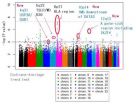(Press-News.org) Scientists on the Norwich Research Park, working with colleagues in China, have developed new techniques that will aid the application of genomics to breeding the improved varieties of crop needed to ensure food security in the future. By dissecting the complicated genome of oilseed rape they have been able to produce maps of the genome that are needed for predictive breeding.
Traditional breeding involves crossing two varieties and selecting the best performing among the progeny. Predictive breeding is a more advanced technique where specific parts of the genome most likely to contain beneficial genes are identified.
Genomic sequencing and the availability of genetic linkage maps can play a major part in predictive breeding efforts by linking beneficial traits to specific parts of the genome. Researchers and breeders use genetic markers to construct linkage maps, which help to identify useful genes. They are also vital to marker-assisted crop breeding, where the maps and markers can greatly accelerate the breeding in of new improved traits.
However, for key crops such as bread wheat and oilseed rape, the use of this kind of genomics-based predictive crop breeding is severely hampered due to the complicated genomes that these species possess. Many important crop plants are polyploid, possessing several sets of chromosomes. Bread wheat, for example, contains three pairs of chromosomes derived from multiple hybridisation events that occurred between two other wheat species relatively recently in its ancestry. To try to overcome this problem, a team from the John Innes Centre and The Genome Analysis Centre (TGAC), which are strategically supported by the BBSRC, combined sequence data from different sources to construct genetic linkage maps.
The team led by Professor Ian Bancroft worked on oilseed rape, which as well as being an important oil crop also plays a key role in crop rotation strategies. Its oil has industrial applications and its straw can be used for biofuel production. Like bread wheat, oilseed rape (Brassica napus) has a complicated genome, having recently been formed from related species Brassica rapa and Brassica oleracea.
The strategy adopted by the group involves integrating the available sequence data for oilseed rape with that of its ancestral progenitors, and also that of a more distantly-related species for which high-quality genome sequence data is available, in this case the model plant Arabidopsis thaliana.
Instead of trying to sequence the DNA, the team focussed on the RNA transcribed from the DNA when the genetic code is expressed. The complete set of all of this transcribed RNA is known as the transcriptome.
TGAC used the Illumina GAII platform for the study, producing a series of consistently high quality sequence datasets from expressed genes.
The team analysed the transcriptome in juvenile leaves, which gives an overview of all of the genes that are expressed in that tissue. Using the sequence variation the researchers were able to construct genetic linkage maps in oilseed rape, eventually identifying over 23,000 markers. This allowed them to align the oilseed rape genome with that of Arabidopsis thaliana and also to sequence data from oilseed rape's two progenitor species.
This method of dissecting the genome of polyploid crops is likely to be equally applicable to other important crops. Bread wheat is a prime candidate for this, using the model grass Brachypodium distachyon in the place of Arabidopsis.
"Dissecting the genome of oilseed rape like this opens up the possibility of using predictive breeding techniques that will really help with the production of improved varieties" said Prof. Bancroft.
INFORMATION:
This study was published in Nature Biotechnology and funded by the BBSRC, the Department for Environment, Food and Rural Affairs and the China National Basic Research and Development Program.
Dissecting the genomes of crop plants to improve breeding potential
2011-08-01
ELSE PRESS RELEASES FROM THIS DATE:
Columbia engineering innovative hand-held lab-on-a-chip could streamline blood testing worldwide
2011-08-01
New York, NY—July 31, 2011—Samuel K. Sia, assistant professor of biomedical engineering at Columbia Engineering, has developed an innovative strategy for an integrated microfluidic-based diagnostic device—in effect, a lab-on-a-chip—that can perform complex laboratory assays, and do so with such simplicity that these tests can be carried out in the most remote regions of the world. In a paper published in Nature Medicine online on July 31, Sia presents the first published field results on how microfluidics—the manipulation of small amounts of fluids—and nanoparticles can ...
Genome-wide study reveals 3 new susceptibility loci for adult asthma in Japanese population
2011-08-01
Researchers at the RIKEN Center for Genomic Medicine (CGM), together with colleagues at Kyoto University, Tsukuba University, Harvard University, and other medical institutions have identified three new loci associated with susceptibility to adult asthma in the Japanese population. The findings appear in Nature Genetics and derive from a genome-wide study of 4836 Japanese individuals.
Around the world, hundreds of millions of people suffer from bronchial asthma, a chronic inflammatory disease characterized by symptoms of wheezing, shortness of breath and coughing. In ...
Researchers discover the mechanism that determines cell position in the intestinal epithelium
2011-08-01
How do cells know where to position themselves and where to accumulate in order to carry out their functions correctly within each organ? Researchers with the Colorectal Cancer Lab at IRB Barcelona have revealed the molecular mechanisms responsible for organizing the intestinal epithelium into distinct comportments, defined by frontiers or territories. The study, headed by Eduard Batlle, coordinator of the Oncology Programme at IRB Barcelona and ICREA Research Professor, is published in today's online version of the Journal Nature Cell Biology, part of the prestigious editorial ...
CSHL scientists reveal mechanism behind 'oncogene addiction' in acute leukemia
2011-08-01
Cold Spring Harbor, NY – A team of scientists at Cold Spring Harbor Laboratory (CSHL) has laid bare the mechanism behind a phenomenon called oncogene addiction in mice suffering from a form of leukemia that mimics acute myelogenous leukemia (AML) in humans. Significantly, the team was able to mobilize their newly gained understanding to target "addiction" pathways in the model mice, resulting in rapid and complete eradication of the cancer, which is usually fatal and resistant to conventional chemotherapy.
Oncogene addiction refers to the curious phenomenon that cancer ...
Physicists show that quantum ignorance is hard to expose
2011-08-01
No-one likes a know-it-all but we expect to be able to catch them out: someone who acts like they know everything but doesn't can always be tripped up with a well-chosen question. Can't they? Not so. New research in quantum physics has shown that a quantum know-it-all could lack information about a subject as a whole, yet answer almost perfectly any question about the subject's parts. The work is published in Physical Review Letters.
"This is something conceptually very weird," says Stephanie Wehner of the Centre for Quantum Technologies at the National University of ...
70 percent of 8-month-olds consume too much salt
2011-08-01
Seventy per cent of eight-month-old babies have a salt (sodium chloride) intake higher than the recommended UK maximum level, due to being fed salty and processed foods like yeast extract, gravy, baked beans and tinned spaghetti.
Many are also given cows' milk, which has higher levels of salt than breast or formula milk, as their main drink despite recommendations that it should not be used in this way until babies are at least one year old. High levels of salt can damage developing kidneys, give children a taste for salty foods and establish poor eating practices that ...
Effects of tobacco use among rural African American young adult males
2011-08-01
Alexandria, VA — Tobacco related disease is a primary source of mortality for African American men. Recent studies suggest that "alternative" tobacco products may have supplanted cigarettes as the most common products used by young African Americans, according to new research published in the August 2011 issue of Otolaryngology – Head and Neck Surgery.
While the tobacco-related disease burden is higher in African American adults, prevalence rates of tobacco use among young African American teens are surprisingly lower than those reported for whites. This picture changes ...
Doctors: Colon cleansing has no benefit but many side effects including vomiting and death
2011-08-01
Washington, D.C. – Colon cleansing - it's been described as a natural way to enhance well-being, but Georgetown University doctors say there's no evidence to back that claim. In fact, their review of scientific literature, published today in the August issue of The Journal of Family Practice, demonstrates that colon cleansing can cause side effects ranging from cramping to renal failure and death.
The procedure, sometimes called colonic irrigation or colonic hydrotherapy, often involves use of chemicals followed by flushing the colon with water through a tube inserted ...
Community hospital implements successful CT radiation dose reduction program
2011-08-01
In an effort to reduce the radiation dose delivered by computed tomography (CT) scans, staff at a community-based hospital developed a comprehensive CT radiation dose reduction program which has allowed them to reduce the radiation dose delivered by CT scans at their facility, according to an article in the August issue of the Journal of the American College of Radiology.
CT is an essential tool for the accurate diagnosis of disease and injury but is associated with radiation doses higher than those of conventional X-ray imaging. Although high doses of radiation are ...
Experts offer pointers for optimizing radiation dose in head CT
2011-08-01
An article in the August issue of the Journal of the American College of Radiology summarizes methods for radiation dose optimization in head computed tomography (CT) scans. Head CT is the second most commonly performed CT examination, with 28 percent of the total number of CT examinations.
Magnetic resonance imaging (MRI) has emerged as the imaging modality of choice for a vast majority of brain and spinal indications. However, CT remains an integral part of modern neuroradiologic practice that can provide lifesaving information about patient management, specifically ...

